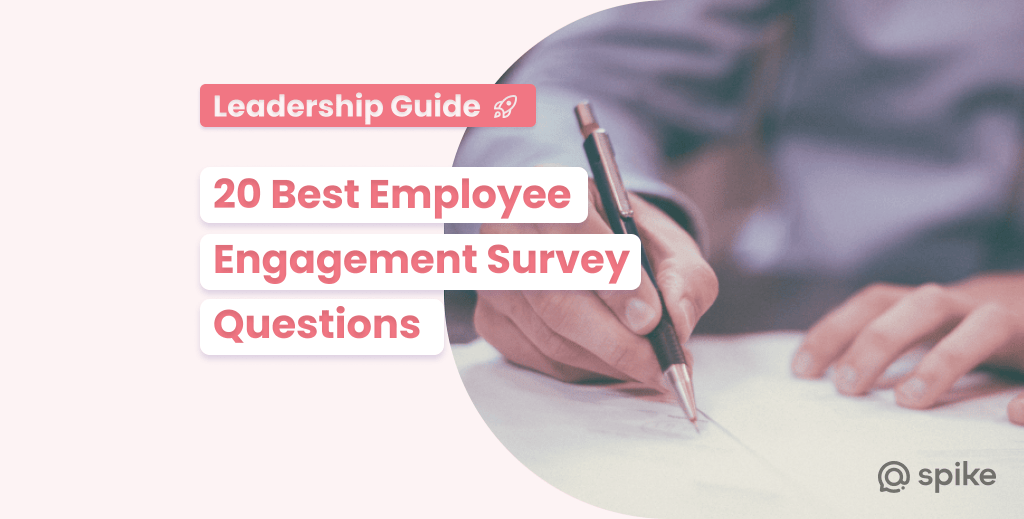20 Best Employee Engagement Survey Questions

Understanding your team’s pulse is not just beneficial – it’s crucial. Employee engagement surveys connect management with their teams’ heartbeats, providing invaluable insights into what drives, motivates, and concerns your workforce.
In this blog, we’ll explore the art and science of crafting the perfect employee engagement survey. Our focus is on more than what to ask; it’s on how to ask it. We’ll present a carefully selected list of the top ten questions that are proven to yield the most insightful responses. These questions are designed to gather data and spark a dialogue that leads to meaningful change.
But we won’t stop there. Alongside these powerful questions, we’ll share expert tips and best practices to elevate the effectiveness of your surveys. From ensuring anonymity to the frequency of surveys, we understand that the devil is in the details of employee engagement surveys. Our guide will equip you with the knowledge to ask the right questions and create an environment where these questions can lead to impactful actions.
So, whether you want to revitalize your team, enhance productivity, or simply understand your employees better, our guide is your starting point. Dive in and discover how the right questions can transform the culture of your workplace.
What Are Employee Engagement Surveys?

Before diving into the intricacies of the questions themselves, it’s essential to understand employee engagement surveys and why they’re so significant in the modern workplace. At their core, employee engagement surveys are tools organizations use to measure and understand how invested employees are in their work and the company. They’re not just questionnaires but powerful instruments for gauging the health of an organization’s culture and its impact on performance.
Employee engagement surveys go beyond mere satisfaction; they explore a range of factors that contribute to an employee’s commitment and enthusiasm toward their job and the organization. These factors can include feelings of appreciation, alignment with company values, understanding of strategic goals, relationships with supervisors and peers, and opportunities for growth and development.
The primary aim of these surveys is to identify strengths and weaknesses within the organization from an employee’s perspective. They provide a voice to the workforce, allowing employees to express their views on various aspects of their work life. This feedback is invaluable for leaders and managers, as it helps them understand what motivates their employees, what challenges they face, and what changes could lead to improved performance and job satisfaction.
Moreover, employee engagement surveys are a catalyst for change. They help organizations to make data-driven decisions and implement strategies that foster a more engaged and productive workforce. When conducted regularly and acted upon, these surveys can lead to continuous improvement in various areas such as leadership effectiveness, communication, teamwork, and overall workplace environment.
In summary, employee engagement surveys are about collecting data and initiating a conversation with your employees. They provide insights that can drive meaningful change, ultimately leading to a more engaged workforce and a thriving company culture.
Why Are Surveys Effective At Measuring Employee Engagement?
Understanding why employee engagement surveys are effective is as crucial as knowing what to ask in these surveys. These surveys excel in measuring engagement and satisfaction levels for several key reasons:
1. Comprehensive Insight Into Employee Sentiments
Employee engagement surveys are uniquely positioned to gather extensive data across various dimensions of an employee’s work life. They can tap into aspects like job satisfaction, alignment with organizational values, professional development opportunities, and relationships with management and peers. This comprehensive approach gives managers a holistic view of an employee’s experience and engagement levels within the organization.
2. Quantifiable Data to Inform Decision Making
Surveys provide quantifiable data that can be analyzed to identify trends, patterns, and areas of concern. This data-driven approach empowers managers to make informed decisions and implement targeted strategies to address specific issues. For instance, a consistent pattern of low scores in a particular area can highlight an underlying problem that might need to be visible through casual observations or informal discussions.
3. A Platform for Employee Voice
One of the most significant benefits of engagement surveys is that they give employees a voice. Allowing employees to express their opinions, concerns, and suggestions anonymously encourages honesty and openness. This act of listening is a powerful tool in itself for enhancing engagement. When employees feel heard, know that their feedback is valued, and can lead to real change, their sense of belonging and commitment to the organization strengthens.
4. Identification of Hidden Issues and Opportunities
Engagement surveys can uncover issues that take time to become apparent through regular interactions or performance metrics. They can reveal hidden challenges like process bottlenecks, gaps in communication, or even deeper issues related to company culture. Similarly, surveys can highlight unexpected strengths and opportunities for further development.
5. Fostering a Culture of Continuous Improvement
Regularly conducting these surveys demonstrates a commitment to continuous improvement and employee well-being. It sets a precedent within the organization that employee feedback is not only welcomed but is a critical component of the company’s growth strategy. This ongoing feedback and improvement process contributes significantly to building a positive, engaged, productive work environment.
In short, employee engagement surveys are much more than a tool for measurement; they are a cornerstone for building a responsive, employee-centric culture. By effectively utilizing the insights gained from these surveys, managers can foster a workplace where employees feel engaged, valued, and motivated to contribute their best.
20 Best Employee Engagement Survey Questions
Employee engagement surveys are essential for understanding the dynamics of your workplace. Here’s a list of 20 impactful survey questions, each designed to gauge different aspects of employee engagement:
-
How meaningful is your work?
This question assesses an employee’s job’s intrinsic motivation and satisfaction, revealing their connection to their tasks and responsibilities.
-
Do you have the resources and tools to perform your job effectively?
It focuses on whether employees have the necessary tools and resources, which is fundamental for job performance and satisfaction.
-
How well do you understand the strategic goals of the organization?
This measures employees’ alignment with the company’s vision and their understanding of how their work contributes to organizational objectives.
-
Do you feel valued at work?
This question gets to the heart of employee recognition, a critical factor in engagement and motivation.
-
How comfortable do you feel giving feedback to your manager?
It gauges the openness and effectiveness of communication between employees and their managers.
-
How effectively does our team work together?
This assesses the quality of teamwork and collaboration within the organization.
-
Are you satisfied with your opportunities for professional growth?
It measures employees’ perceptions of their career progression and development opportunities.
-
Is the management team transparent?
Transparency from management is critical for trust and engagement, and this question assesses that directly.
-
How fair and equitable do you find the compensation and benefits here?
Addresses the often-sensitive topic of remuneration and its fairness, a significant factor in employee satisfaction.
-
Do you feel respected and included regardless of your background or identity?
Measures the effectiveness of diversity and inclusion initiatives and the overall workplace culture.
-
How safe do you feel in the workplace?
Assesses the physical and psychological safety of the work environment, which is essential for employee well-being.
-
How often do you feel stressed at work?
It helps identify potential issues with workload and stress, which is crucial for maintaining a healthy work-life balance.
-
Are your opinions heard and considered by management?
Measures whether employees feel their voice matters in the organization.
-
How would you rate your overall satisfaction with your team's communication?
Evaluates the effectiveness of communication within teams.
-
Is there someone at work who encourages your development?
Looks at mentorship and support from colleagues and its impact on employee engagement.
-
How likely are you to recommend our company as a great place to work?
Serves as a litmus test of overall employee satisfaction and engagement.
-
Do you feel your work-life balance is respected?
Addresses the critical aspect of work-life integration.
-
How confident do you feel about the future of the company?
Gauges employees’ confidence in the company’s future.
-
Is your job role clear and your responsibilities well-defined?
Focuses on the clarity of role and responsibilities.
-
How satisfied are you with your team’s decision-making process?
Assesses the effectiveness and fairness of decision-making processes within teams.
These questions cover a range of categories, including collaboration, management, career development, company culture, resources, team communication, diversity & inclusion, compensation, company direction, and safety. By addressing these areas, you can gain a comprehensive understanding of your employees’ engagement levels and identify areas for improvement.
How To Get the Most Out of An Employee Engagement Survey

Conducting an employee engagement survey is just the first step. To truly benefit, it’s vital to optimize its design and execution. Here are several tips to enhance the effectiveness of your survey:
1. Thoughtful Survey Design
- Keep it Concise: Lengthy surveys can be overwhelming. Aim for a balance between comprehensiveness and brevity to maintain high response rates.
- Mix Question Types: Utilize a mix of multiple-choice and open-ended questions. While multiple-choice questions simplify analysis, open-ended questions can uncover nuanced insights.
2. Anonymity vs Named Responses
- Anonymity Pros: Encourages honesty and reduces the risk of biased responses. Employees are more likely to share candid feedback without fear of repercussions.
- Anonymity Cons: Limits the ability to follow up for more context or address specific issues raised by individuals.
- Named Responses Pros: Allows for personalized follow-ups and specific issue resolution.
- Named Responses Cons: This may lead to more guarded responses, impacting the authenticity of the feedback.
3. User-Friendly Format
- Opt for a clear, easy-to-navigate format. A user-friendly interface encourages completion and ensures a broader range of employees can participate without confusion or frustration.
4. Data Collection and Interpretation
- Use Reliable Tools: Employ robust survey tools to handle data efficiently and securely.
- Data Analysis: Don’t just collect data; analyze it to uncover patterns and trends. Consider using data analysis tools to help interpret results.
- Actionable Insights: Translate findings into actionable insights. Data is only as valuable as the actions it inspires.
5. Frequency and Timing
- Regular surveys (annual or bi-annual) help track progress and trends over time. However, avoid over-surveying, as it can lead to survey fatigue.
6. Communicate the Purpose and Follow Up
- Communicate the survey’s purpose to your employees. Post-survey, share results and planned actions to demonstrate their feedback is valued and acted upon.
7. Multiple Choice vs Free Form
- Multiple Choice: Provides structured, quantitative data that are easier to analyze. It’s ideal for measuring specific aspects and benchmarking over time.
- Free Form: Offers qualitative insights and unstructured feedback, valuable for understanding the ‘why’ behind employee sentiments.
By implementing these tips, your employee engagement survey can become a more effective tool for understanding and enhancing employee satisfaction and productivity. Remember, the goal is to measure the engagement and foster it.
FAQ
Employee engagement surveys should be conducted annually or bi-annually. This frequency allows organizations to track progress and respond to changes effectively without causing employee survey fatigue.
The ideal length varies, but a survey should take approximately 15-20 minutes to complete. This length ensures that you cover essential topics manageable for your employees, leading to higher completion rates and more accurate responses.
Anonymity in surveys is often recommended as it encourages more honest responses. However, if the organizational culture supports open and transparent communication, named surveys can be effective for direct follow-ups and personalized action plans.
To increase response rates, ensure the survey is concise and user-friendly. Communicate its importance and how the results will be used. Offering incentives can also boost participation. Most importantly, it demonstrates that past survey feedback has led to meaningful changes.
To translate survey results into change, thoroughly analyze the data to identify key issues and trends. Share these findings with the team and involve them in brainstorming solutions. Develop an action plan with clear objectives and timelines. Regularly update the team on the progress and impact of these actions.




